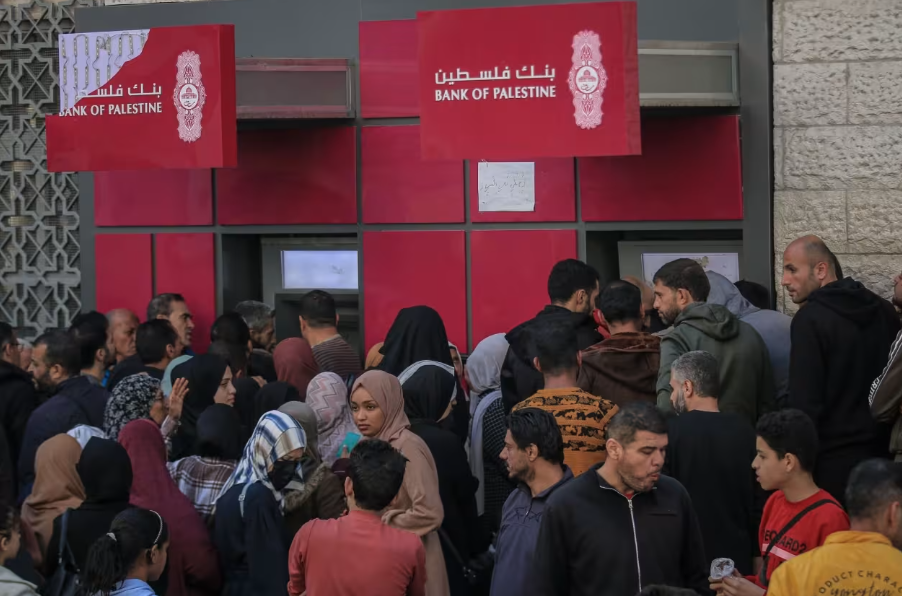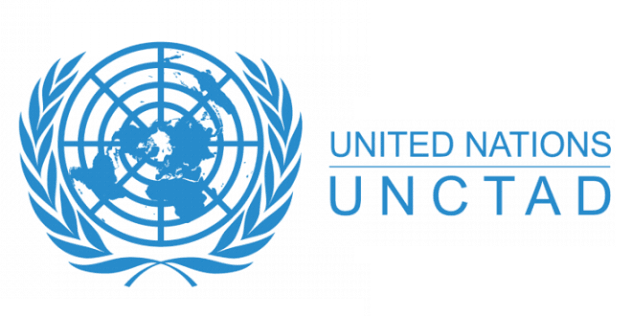WASHINGTON, September 27, 2024 (WAFA) – The World Bank has warned that, nearly 11 months into the ongoing war in the Middle East, the Palestinian territories are nearing an economic freefall amidst a historic humanitarian crisis in Gaza.
Economic contraction has hit unprecedented levels, with the overall GDP in the Palestinian territories shrinking by 35% in the first quarter of 2024, according to the World Bank. Gaza's economy faced an alarming 86% contraction, dropping its share of the Palestinian economy from 17% to below 5%, while the West Bank's economy contracted by 25%.
The humanitarian situation in Gaza is dire, with over 41,000 reported fatalities and 96,000 injuries, compounded by the displacement of nearly 1.9 million people. Severe shortages of food, water, fuel, and medical supplies have led to worsening conditions resembling famine.
Financial challenges persist for the Palestinian Authority, which faces an estimated funding gap of $1.86 billion in 2024, more than double the previous year’s shortfall. Despite these challenges, donor contributions are expected to rise, as the World Bank and the European Commission have pledged to increase aid.
Unemployment rates soar
Unemployment rates have soared to record highs, with approximately 50% in the territories, significantly affecting family incomes and workforce stability. Many businesses have been destroyed, leaving families without income, while the remaining economic activities are predominantly informal and occurring at inflated prices in black markets.
In the face of Gaza’s economic stall and the West Bank’s subdued demand, unemployment has reached record highs in both the West Bank and Gaza. The private sector in the West Bank has demonstrated resilience by favoring underemployment over layoffs. Nonetheless, due to the job losses and shortened work hours, 87.2 percent of workers in the West Bank saw their household incomes shrink since the conflict’s onset. Recent surveys by the Palestinian Central Bureau of Statistics (PCBS) and the International Labour Organization (ILO) indicate that roughly two-thirds of firms in the West Bank reported some form of reduction in their workforce.
Collapse of commercial operations
The halt of most commercial operations in Gaza has left most households without any source of income, while the cost of basic commodities has skyrocketed by close to 250 percent. The destruction or damage of most businesses, coupled with the displacement of both owners and workers, have left most households without any source of income.
The surviving economic activities are mostly informal, with essential goods being sold on the black market at exorbitant prices. Compounded by elevated transportation costs and restrictive import policies, these factors have led to a 250 percent increase in the prices of basic commodities in Gaza in August 2024 compared to August of 2023.
Agricultural sector damage
The agri-food economy has been severely damaged, compounding the humanitarian crisis. Damage to agricultural infrastructure, including wells and solar panels, has hindered farming activities and increased production costs. Prior to 2020, agriculture provided formal employment to around 13 percent of the workforce in Gaza and supported the livelihoods of the vast majority, offering informal employment to over 90 percent of the population.
Recent remote sensing analysis by the United Nations Satellite Centre (UNOSAT) reveals that 63 percent of Gaza’s permanent croplands have experienced a decline in crop health and density (an increase of 9 percent since May 2024). Khan Younis, Gaza City, and North Gaza governorates are particularly affected, with approximately 70 percent of their croplands damaged.
Soaring food insecurity
As a result, food insecurity in Gaza has soared, pushing nearly 2 million people to the edge of widespread famine. Nearly all Gazans face acute shortages. The latest IPC analysis indicates that 15 percent of the population (350,000 individuals) is experiencing famine-like conditions, with an almost complete lack of food.
Additionally, one-third of the population is in a state of emergency, suffering from sharp food deficits and higher death rates. These conditions are particularly severe in the northern regions, Gaza City, and the governorates of Deir al-Balah, Khan Younis, and Rafah, with the threat of famine projected to continue through September 2024.
Child and maternal nutrition crisis
An alarming 90 percent of children under the age of two, along with 95 percent of pregnant and breastfeeding women in Gaza are suffering extreme food poverty, consuming two or fewer food groups. Around 95 percent of households limit meals and portion sizes, with two out of three households eating one meal a day.
The education system in Gaza has collapsed. All 625,000 school-aged children of Gaza have been out of school since October 7, 2023. Preliminary estimates suggest that nearly 95 percent of basic, secondary and tertiary education facilities have been damaged or destroyed. The conflict has also severely disrupted education services in the West Bank, with public schools reducing in-person schooling due to fiscal constraints and security concerns.
Healthcare system compromised
Gaza’s health system has been significantly compromised. The impact of the conflict on the health sector is both direct, through damage to health infrastructure, as well as indirect, through the losses incurred as a result of interruptions in service delivery due to the loss of personnel and missing medical supplies and medicines. The destruction of water supply infrastructure and solar panels combined with a lack of grid electricity, fuel for back-up generators and essential inputs have caused 80 percent of the primary care centers (PHCs) to no longer be functional.
As a result of the collapse of the healthcare system, three field hospitals have recently been put in place. Only 17 out of the 36 hospitals with inpatient capacity are partially functional, which represents 53 percent of the total pre-crisis inpatient, ICU, and maternity bed capacity. Approximately 1,500 hospital beds are currently available throughout the Gaza Strip, down from 3,500 beds available before the conflict. The estimated average bed occupancy is almost 300 percent.
Widespread poverty in Gaza
In line with these findings, close to 100 percent of the Gaza population lives in poverty, while households in the West Bank are also suffering from significant welfare losses. Multidimensional poverty in Gaza describes a profoundly distressed situation, affecting both people’s well-being and mental health, with impacts expected to last into the future. The large economic contraction in the West Bank since the end of 2023 is estimated to have translated into a more than doubling of the short-term poverty rate calculated as of mid-2024 from 12 percent to 28 percent.
The Palestinian financial sector—historically a stabilizing force—is showing increased signs of strain. The conflict has intensified existing challenges and introduced new ones such as a critical cash shortage in Gaza. The ongoing economic contraction, the Palestinian Authority’s fiscal struggles, and the increased volatility of cross-border payments all contribute to add pressure.
Cash shortage impacts humanitarian access
In particular, the severe cash shortage in Gaza is impacting the ability of Gazans to access humanitarian assistance and deposits through ATMs and remittances through money transfer operators. This precarious situation underscores the urgent need for measures to safeguard the sector’s integrity and support its recovery.
Maintaining correspondent banking relationships (CBRs) between Palestinian and Israeli banks continues to be critical to prevent systemic economic repercussions. CBRs are essential for the Palestinian economy to conduct financial transactions with Israel and the international community. The recent issues with the renewal of “Letters of Indemnity” have underscored the risks to the Palestinian banking system from a potential disconnection from Israeli banks. Risks were only temporarily mitigated by a 4-months renewal granted by the Government of Israel.
Risks of severing banking relationships
A severance of CBRs would likely cause rapid disruption in key banking services and have profound negative impacts on the Palestinian real sector, especially as the Palestinian economy uses the Israeli Shekel as the primary de facto currency. Importantly, such a severance could also lead to a rise in informal or unregulated financial activities, complicating financial regulation and oversight.
As consistently emphasized in the World Bank’s previous Economic Updates, there are several key actions that must be taken to mitigate the already dire recession, rising poverty, and escalating humanitarian crisis. Foremost, a cessation of hostilities is essential to mitigate the devastating human toll and to begin to restore basic services and kick-start socioeconomic recovery.
Urgent need for funding and reform
"It is imperative to reverse recent unilateral decisions regarding deductions from Clearance Revenues to ensure that the PA has the means to cover vital budgetary obligations, including salaries, pensions, and social services. Concurrently, there is an urgent need for the international community to quickly scale up funding, to maintain essential public services and to commence planning for long-term recovery and reconstruction. Additionally, measures to facilitate trade and strengthen private sector activities in both the West Bank and Gaza are crucial to stimulate income generation."
"Lastly," the report says, "it is of paramount importance that the new Palestinian government remains steadfast in convincingly implementing its reform agenda, with a particular emphasis on governance and fiscal sustainability. Since the new Government’s inauguration less than five months ago, there has been progress in the definition and prioritization of reforms, and the upcoming weeks and months will need to see further acceleration in both design and implementation."
M.N











